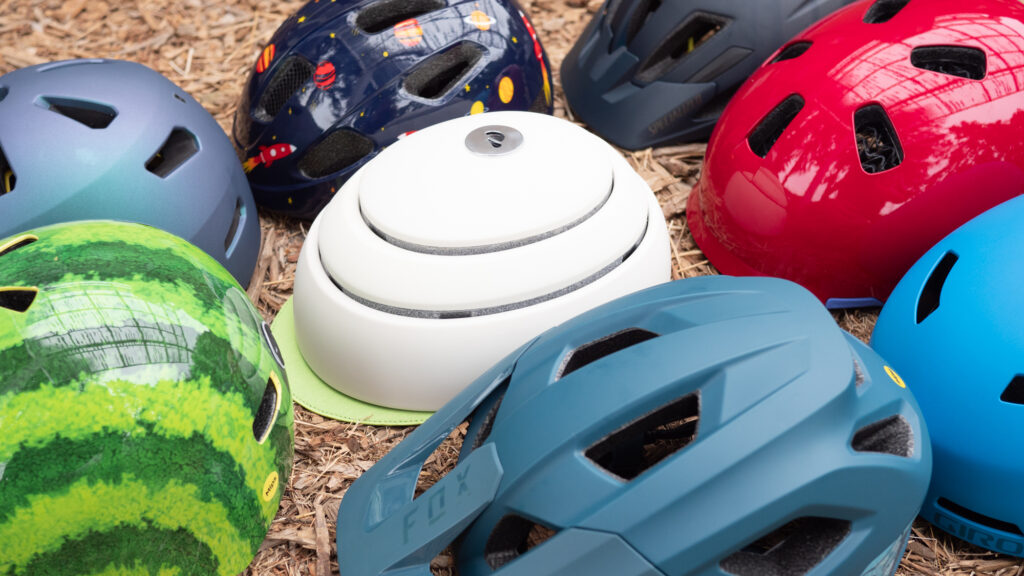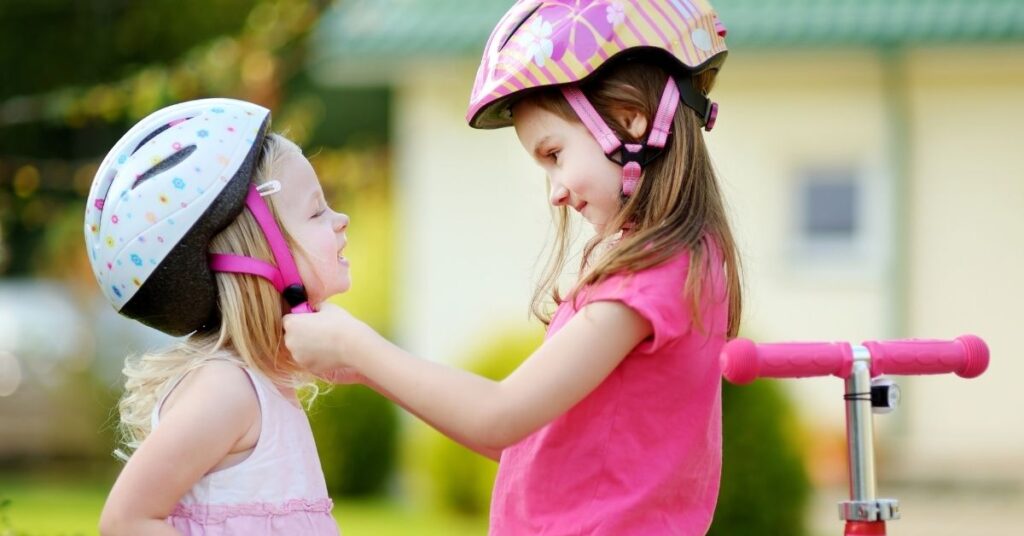Welcome to the Topic “How much are children’s bike helmets”
If you are about to purchase a new helmet for your child, we have compiled some information that will help you choose what features should be included in a children’s bicycle helmet, where to get the appropriate size helmet, and how to properly adjust a child’s bike helmet.
Children can reap several benefits from participating in cycling, including those associated with physical activity, breathing fresh air, and gaining independence and freedom. The hope is that if we can get kids interested in cycling, it will be the beginning of a passion that will last a lifetime.
Even though it’s typically a pretty safe pastime, there is always a chance that someone will get hurt, especially if your kid is still learning how to ride a bike. In light of this, it is strongly recommended that children always wear a helmet when they are riding a bicycle; nonetheless, the decision to do so ultimately rests with you, the parent, or the guardian.
What to look for
Children’s helmets, just like the best road helmets and mountain bike helmets for adults, are built from very inexpensive materials. A more expensive helmet will not necessarily provide superior protection; however, it will provide advantages such as reduced weight, more ventilation, and a more fashionable appearance.
Having said so, check to see if the helmet you are considering buys high marks in the relevant safety ratings.
You should be able to locate the CE mark in the United Kingdom and other European countries, and the helmet should be in compliance with BS EN 1078. (BS stands for British Standard, and EN denotes it is a European standard).
It ought to have the US Snell B90/B95 rating in the United States. These requirements show that the helmet has successfully completed a predetermined series of tests concerning its resistance to impact, retention strap systems, and other similar aspects.
Check for the standard marks, which are typically located on a label inside the helmet. There is nothing that prevents a helmet from being sold, even if it does not satisfy the aforementioned criteria, so it is important to keep this in mind. Helmets manufactured by major companies will comply with the standard, and the staff at your neighborhood bike store will be able to provide you with guidance and recommendations.
A lack of style in a helmet could be a deterrent for your youngster to wear the helmet at all. Thus, it is crucial to get one that has a good appearance. Teenage girls and boys are especially self-conscious about their appearance.
Ventilation becomes increasingly important the longer and faster you ride; while newborns in child seats do not require it, racers must.
Even while all helmets should provide adequate coverage over the top and sides of the skull, the back of the head of newborns’ helmets is made to be significantly deeper than those of older children and adults.
A removable peak is a feature found on many multi-purpose helmets as well as mountain bike helmets. This feature can be helpful for shielding your eyes from the sun or rain. The top isn’t a challenge unless you’re traveling fast on a bike with drop handlebars; in that case, you might not be able to see where you’re going!
The right size
First things first, you’ll need to take your child’s head circumference measurement. Either a tape measure specifically designed for clothing, or a length of thread, which you may then check against a ruler to see how long it is, is required.

Take a horizontal measurement all the way around your child’s head, starting just above the ears and ending approximately two finger widths or an inch above the eyebrows.
The sizes of children’s helmets are typically labeled as baby, toddler, kids, and youth; however, not all manufacturers use the same classification system, and the dimensions of the various sizes may differ depending on the manufacturer.
As a general rule:
- Infant helmets have a circumferential range of about 44 to 50 centimeters. Thus, they should fit youngsters with a head circumference in that range.
- To accommodate children with a head size of around 46 centimeters to 52 centimeters, toddler helmets are designed.
- The average head circumference of a child should be between 48 and 55 centimeters for a well-fitted children’s helmet.
- Junior helmets have a circumference range that often falls between 52 and 58 centimeters, making them suitable for children.
Check the measurement range and try on different helmets to guarantee a comfortable fit. Keep in mind that the size ranges offered by different manufacturers can vary, so it is important to do so.
Because the size of a child’s helmet is determined not just by the child’s age but also by the circumference measurement of the child’s head, once you have this information, you will be able to select the appropriate size helmet.
Do not give in to purchasing a helmet that is too large for the youngster in the hopes that they will “grow into it.” Because it does not fit the child securely, it cannot provide protection in the event that the youngster falls.
How to fit a child’s bike helmet correctly.
First things first, check that the helmet you’ve selected for the kid is the right size for them.
It should be adjusted such that it rests over the ears and horizontally across the center of the forehead; it should not be tilted in either direction. A distance equivalent to the width of two fingers should separate the eyebrows from the front of the helmet.
This is significant because, in the event that the child falls off, the helmet will make contact with the ground instead of the child’s head, regardless of the angle at which they hit it. You may need to adjust the retention system that is located at the back of the helmet.
The helmet should fit comfortably without digging in, yet it should be secure enough that it won’t come off even if the straps aren’t tightened. A good, simple test is to put the helmet on the child’s head without buckling the chin strap and then ask the youngster to bend forward; the helmet should remain in place on the child’s head during this test.
Last but not least, fasten the chin straps so that they are secure without being overly restrictive, and check that the Y-shaped junction is positioned so that it lies just below the ear and passes either side.
When the strap is fastened properly, you should be able to fit a finger in between it and the buckle even though it is closed. When you are putting the helmet on your child, it is a good idea to slide your finger in between the clip mechanism and your child’s chin. This will help prevent their skin from becoming caught in the mechanism by accident.
If the youngster is not accustomed to wearing it, it will feel unusual to them at first, and many of them will want to push it back on their head and off their forehead. It is essential to encourage them to maintain it in the appropriate posture and to become accustomed to the sensation.
Different types of helmet
It is not uncommon to see riders, particularly BMXers and dirt jumpers, wearing hard-shell helmets that are more similar in appearance to skating helmets. These are durable but have poorer ventilation than other options, and in recent years have seen a surge in popularity, particularly among adolescents.
Full-face helmets offer even greater protection, particularly to the chin and face, and are worn almost exclusively by downhill mountain bikers and enduro riders. Full-face helmets protect the face and chin in particular. They have the appearance of motorcycle helmets but are significantly lighter and more delicate.
The acronym MIPS refers to the Multi-directional Impact Protection System, which is included in some types of helmets. In the event of a collision, this is intended to provide additional protection by mitigating the influence of rotational forces on the head rather than merely the direct forces that are normally evaluated for head protection.
All of these head protection options are also available in sizes and styles that are more suitable for children.

Prices of Helmets
- Specialized Mio MIPS Helmet for Toddlers – $60
Hemmes recommends the Mio helmet from Specialized as the best option for children’s heads. It has a magnetic closure, which he describes as “pinch-free and the best there is in terms of simplicity of use.” Hemmes goes on to say that the helmet has “excellent” rear coverage and that its retention mechanism is top-notch (or the adjustable frame inside it)
- Lazer Gekko MIPS helmet – $65
Martin, Watson, and Dean Mullin, who is a co-owner of Clever Cycles in Portland, Oregon, all prefer the Lazer Gekko, which is an extremely mature-appearing helmet that they claim is probably the easiest to fit any helmet that is now available.
- Woom Bikes Kids’ Helmet – $69
Woom, an Austrian company that also happens to be the manufacturer of one of our most recommended bicycles for children, has given a great deal of time and consideration to the design of its characteristic helmet. This durable helmet protector comes highly recommended to us by Lee Uehara of City Bike Coach. It has cushioning on the interior as well as chin straps, and it offers a lot of adjustabilities.
- Nutcase Little Nutty Helmet with MIPS – From $70
Nutcase is one of Varn’s favorite brands of helmets, “particularly for smaller kids,” he says. This also holds true for Mullin. He makes the observation that “kids are hard on helmets.” “They take them off and drop them exactly where they are,” he says, which is an action that can eventually weaken their protective components, such as foam. “They take them off and drop them right where they are.”
- Joovy Noodle Kids’ Bike Helmet – From $61
The Noodle is a lightweight, comfy, and inexpensive choice that comes in a wide selection of colors and is available in two sizes for both toddlers and preschoolers. It is also available in a wide range of colors. Martins adores the way it fits, and she believes that her customers’ children appreciate the color-coded buckle that prevents pinching. She also claims that it is beneficial for children who ride their bicycles while seated in bike seats, bike trailers, or balancing bikes.
WudeBike
Now that you have a much better grasp of the reasons why low-cost bicycles are not the option that should be picked for children, have a look at the many different bicycles that we have available for you to choose from.
Have any questions regarding the topic “How much are children’s bike helmets” feel free to comment below.
Also Read: Best Balance Bikes for Kids of All Ages
